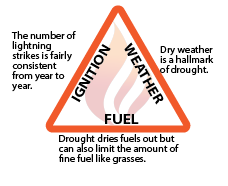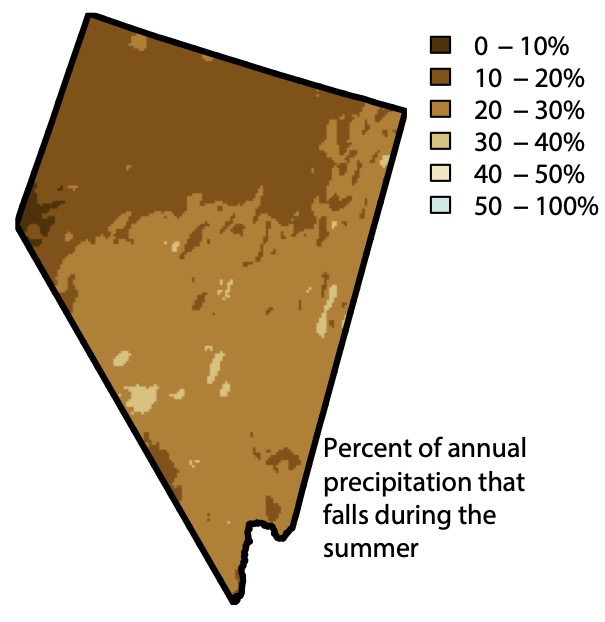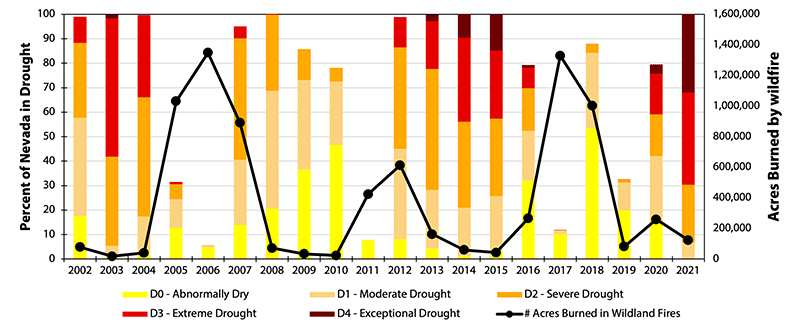Drought and Fire in Nevada: Is fire risk higher during drought?
Fire
Wildfires burn in natural areas such as forests and rangelands. They are necessary and important processes in the natural landscape, but they are, as the Federal Emergency Management Agency notes, “unplanned” in contrast to planned prescribed fires. Wildfires can be beneficial, but they can also negatively impact our communities’ safety, health and livelihoods.
 Figure 1. The fire triangle describes the ingredients necessary for wildfire.
Figure 1. The fire triangle describes the ingredients necessary for wildfire.
Wildfire is driven largely by three major factors described in the fire triangle (Figure 1). These factors are:
- Weather: Fire tends to spread faster in hot, dry windy weather.
- Fuel: How much living and dead plant material is there, and how dry is it? Fire can spread more readily when there’s abundant dry fuel.
- Ignition: Something has to start the fire. That can be lightning or a spark created by human activities such as campfires, target shooting or even lawn maintenance.
In Nevada, fire is most likely during the state’s hot dry summers (Figure 2). Most of Nevada gets less than a third of its annual precipitation between the beginning of June and the end of September. Parts of northwestern Nevada get less than 10% of the annual precipitation in those four months. Fire is also common in the early autumn, before winter-type storms have started dropping rain and snow.

Figure 2. Most of Nevada has a dry summer, with less than 30% of the annual total precipitation falling between Jun. 1 and Sept. 30. Based on PRISM 1991 - 2020 averages.
Drought
Drought can be challenging to define, and there are many different descriptions and definitions of drought. Essentially, drought is a period of drier than normal weather that is severe enough and/or long enough to impact ecosystems, water supplies or human activities. Drought can last for weeks, months or years. Often, drought is caused by an unusual lack of rain or snow. Long periods of dry, sunny weather during the summer are normal for Nevada (Figure 2) and do not necessarily mean drought. High temperatures during the spring, summer and fall can worsen or even cause drought by increasing the atmosphere’s demand for moisture. Warm temperatures during the winter can cause snow drought, where the snowpack is smaller than normal and melts earlier, allowing soils and vegetation to start drying earlier in the spring.
There are many ways to track drought, but one common tool is the U.S. Drought Monitor, which combines many lines of evidence to assess drought conditions each week. The U.S. Drought Monitor characterizes conditions as no drought, D0 – Abnormally Dry, and as droughts of increasing severity. In D1 – Moderate Drought, most measures of drought indicate conditions among the driest fifth expected in a region. D2 – Severe Drought, D3 – Extreme Drought, and D4 – Exceptional Drought are shown when conditions are in the bottom tenth, twentieth or fiftieth, respectively.
Drought and Wildfire in Nevada
Drought impacts two sides of the fire triangle – fuel and weather. There is little evidence to suggest that drought influences the amount of lightning in Nevada. Drought is, by definition, characterized by the kind of hot, dry, weather that allows fire to burn and spread, but that kind of weather is common in Nevada, even without drought.
Whether drought tends to increase or decrease fire risk depends on the type of vegetation and how long the drought lasts. Drought impacts vegetation, the fuel for wildfires, in two competing ways. First, drought controls the amount of moisture in live and dead vegetation. Drier vegetation is more likely to burn. This happens quickly for grasses and herbs. In fact, because summers in Nevada are dry (Figure 2), grasses “cure” (dry out enough to burn) in most years, so drought does not make fire more likely in ecosystems dominated by grasses and herbs (Table 1). As drought lengthens or becomes more severe, heavier vegetation such as shrubs and trees start to dry out, so fire risk does increase with drought in forests and woodlands.
Conversely, drought can limit the amount of fuel available to burn. Severe droughts or droughts that last multiple years reduce the growth of grasses, herbs and fast-growing shrubs, which ultimately reduces the amount of fuel that is available to burn, making fire less likely. In many Nevada ecosystems, long droughts limit vegetation growth, reducing the risk of fire. Drought tends not to reduce the amount of fuel in forests as much, because fuel accumulates over many years.
Table 1: Drought and wildfire interactions in Nevada ecosystems (Based on information in the 2020 Nevada Forest, Range & Watershed Action Plan.)
Forests and Woodlands:
Fire is more likely with drought, especially prolonged drought, which can dry out even the largest trees, making them more flammable.
Sagebrush:
Fire is somewhat less likely during long droughts because plants grow poorly, limiting the amount of fuel.
Cold Desert Grass and Shrublands:
Fire is somewhat less likely during long droughts because plants grow poorly, limiting the amount of fuel.
Warm and Hot Deserts:
During droughts, already dry deserts tend not to burn very often. Fire is most likely if wet conditions cause unusually lush growth of grasses and herbs that then dry out.
Much of Nevada is covered by sagebrush, cold grass and shrublands, and warm or hot deserts, where vegetation dries out enough to burn in most summers. In those environments, drought tends to limit vegetation growth. As a result, big fire years in Nevada, especially in lower elevations, are more common in nondrought years than in drought years (Figure 3). This is different than in many other parts of the West, including the forests of the Sierra Nevada, where wildfire is more likely during drought.

Figure 3. Comparison between the amount and severity of drought in Nevada (colored bars) and the acres burned by wildfires (black line) shows that more area burns in nondrought years than in drought years. Data from the U.S. Drought Monitor and the National Interagency Fire Center. Note that the percent area shown is the calendar year average of weekly U.S. Drought Monitor data.
In the last two decades, Nevada’s biggest wildfire years were 2006 and 2017, both of which were relatively wet (Figure 3). Drought years with a lot of fire, like 2007, 2012, and 2018, tend to occur after relatively wet years. It seems counter-intuitive, but because of the already dry climate and the vegetation that grows here, wildfires in non-drought years can burn many, many acres. This means it’s important to remain Ember Aware every year.
How can I live more safely with wildfire?
- Learn more about preparing your home and community for wildfire at Living With Fire, where you can find resources such as the Wildfire Home Retrofit Guide, which contains suggestions for making your home more resistant to fire; information about choosing plants for defensible space; and checklists to help you prepare for poor air quality, evacuations and returning home after a fire.
- Check out Ready for Wildfire for tips on how to prevent wildfires in the first place. Even small steps such as mowing the lawn before 10 a.m. when it’s cooler and not driving or parking on dry vegetation can reduce the chances of accidentally starting a fire.
- Stay aware of current Fire Restrictions at Nevada Fire Info.
References
- Bollinger, B. (2019) How drought prone is your state? National Integrated Drought Information System (NIDIS). https://www.drought.gov/news/how-drought-prone-your-state-look-top-states-and-counties-drought-over-last-two-decades
- Higuera, P.E. (2015). Taking time to consider the causes and consequences of large wildfires. Proceedings of the National Academy of Sciences, 112(43), 13137-13138.
- Littell, J.L., McKenzie, D., Peterson, D.L., & Westerling, A.L. (2009). Climate and wildfire area burned in US ecoprovinces, 1916-2003. Ecological Applications, 19(4), 1003-1021.
- National Integrated Drought Information System (NIDIS). Drought Basics: Defining Drought. https://www.drought.gov/what-is-drought/drought-basics#defining-drought
- Nevada Division of Forestry (NV DOF). (2020). Nevada Forest, Range & Watershed Action Plan. https://forestry.nv.gov/uploads/missions/20210519_AMT_2020_Nevada_FRWAP_Public_Version.pdf
- Orville, R.E., Huffines, G.R., Burrows, W.R., & Cummins, K.L. (2011). The North American lightning detection network (NALDN)—Analysis of flash data: 2001–09. Monthly Weather Review, 139(5), 1305-1322.
- PRISM Normals. https://prism.oregonstate.edu/normals/
- Statistics. (2022). National Interagency Fire Center. https://www.nifc.gov/fire-information/statistics
- State Boundaries. U.S. Department of Commerce, U.S. Census Bureau, https://www.sciencebase.gov/catalog/item/52c78623e4b060b9ebca5be5
- U.S. Drought Monitor (USDM). (2022). Nevada, Comprehensive Statistics [Data File]. Retrieved from https://droughtmonitor.unl.edu/DmData/DataDownload/ComprehensiveStatistics.aspx
Davis, A., McAfee, S., Restaino, C., Ormerod, K.J.
2022,
Drought and Fire in Nevada: Is fire risk higher during drought?,
Extension, University of Nevada, Reno Factsheet


